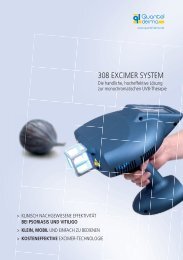Evaluation of the Aura 532nm laser and the Lyra ... - LEDA EPI
Evaluation of the Aura 532nm laser and the Lyra ... - LEDA EPI
Evaluation of the Aura 532nm laser and the Lyra ... - LEDA EPI
You also want an ePaper? Increase the reach of your titles
YUMPU automatically turns print PDFs into web optimized ePapers that Google loves.
Hair removal with Low Fluence<br />
Hair Removal Mode – <strong>LEDA</strong> <strong>EPI</strong><br />
Maurice A. Adatto, M. D.,<br />
Founder & Medical Director<br />
Skinpulse Dermatology, Laser & Beauty Centres, Geneva, Switzerl<strong>and</strong><br />
Background<br />
It is general knowledge that <strong>laser</strong> with a wavelength <strong>of</strong> about 800 nm remove hair well using<br />
st<strong>and</strong>ard settings for pulse duration <strong>and</strong> energy density (fluence).<br />
Studies [1] <strong>and</strong> [2] discuss <strong>the</strong> use <strong>of</strong> low fluence in hair removal with an 810-nm diode <strong>laser</strong>.<br />
Several passes are applied to <strong>the</strong> treated area. With this method, <strong>the</strong> amount <strong>of</strong> energy applied<br />
to each part <strong>of</strong> <strong>the</strong> treatment area cannot be specified <strong>and</strong> <strong>the</strong> exact interval between <strong>the</strong> <strong>laser</strong><br />
pulses is unclear. However, <strong>the</strong> treatment with low fluence <strong>and</strong> several passes is significantly<br />
less painful than regular hair removal with high fluence. No significant differences in<br />
effectiveness were observed when comparing both methods.<br />
A new diode <strong>laser</strong> system (<strong>LEDA</strong> <strong>EPI</strong> 808, Quantel Derma GmbH, Erlangen, Germany) was<br />
recently introduced into <strong>the</strong> market. It automatically applies multiple low fluence <strong>laser</strong> pulses<br />
(sub-pulses) with defined intervals at <strong>the</strong> same spot. Also, <strong>the</strong> number <strong>of</strong> sub-pulses can be<br />
defined. This eliminates <strong>the</strong> need for multiple passes.<br />
Objective<br />
This case study compares <strong>the</strong> effectiveness <strong>of</strong> multiple pulse, low fluence hair removal <strong>and</strong><br />
st<strong>and</strong>ard single-pulse, high fluence hair removal.<br />
Materials <strong>and</strong> Methods<br />
Treatment <strong>of</strong> one patient, side by side<br />
comparison: right side <strong>of</strong> <strong>the</strong> body with<br />
high fluence hair removal, left side <strong>of</strong> <strong>the</strong><br />
body with low fluence hair removal.<br />
The treatments were done with <strong>LEDA</strong> <strong>EPI</strong><br />
808, Quantel Derma GmbH, using <strong>the</strong><br />
following parameters:<br />
High Fluence Hair Removal<br />
Low Fluence Hair Removal<br />
Pulses: 1<br />
Pulses: 1 (consisting <strong>of</strong> 2 sub-pulses)<br />
Interval: 0.3 s<br />
Fluence: 27-42 J/cm2 Total Fluence: 24 J/cm 2<br />
Pulse duration: 9-30 msec<br />
Pulse duration: 6 msec
With <strong>the</strong> low fluence hair removal, <strong>the</strong><br />
total fluence is not applied in a single<br />
pulse, but is divided into multiple separate<br />
sub-pulses. These sub-pulses (stacked<br />
pulses) are applied at <strong>the</strong> same spot. The<br />
heat accumulates in <strong>the</strong> hair roots <strong>and</strong> <strong>the</strong><br />
surrounding area due to <strong>the</strong> relatively long<br />
<strong>the</strong>rmal relaxation time. The epidermis<br />
cools down between <strong>the</strong> shots, so that <strong>the</strong><br />
temperature <strong>of</strong> <strong>the</strong> epidermis stays below<br />
<strong>the</strong> critical level.<br />
High Fluence<br />
Before treatment<br />
Low Fluence<br />
Results<br />
High Fluence<br />
Low Fluence<br />
With low fluence hair removal, patient<br />
comfort is much higher. The effectiveness<br />
is similar to st<strong>and</strong>ard high fluence hair<br />
removal.<br />
Clinical Images<br />
The images show that <strong>the</strong> number <strong>of</strong> hairs<br />
is visibly reduced on both sides <strong>of</strong> <strong>the</strong> body:<br />
3 months post 4 treatments<br />
High Fluence<br />
Low Fluence<br />
Conclusion<br />
Hair removal with two low fluence subpulses<br />
is safe, comfortable for <strong>the</strong> patient<br />
<strong>and</strong> effective. Fur<strong>the</strong>r evaluation on more<br />
patients <strong>and</strong> dark skin is necessary.<br />
Before treatment<br />
Note:<br />
This case study is part <strong>of</strong> an ongoing<br />
large multicenter study.<br />
High Fluence<br />
Low Fluence<br />
Literature<br />
[1] Braun M. Permanent Laser Hair Removal With Low<br />
Fluence High Repetition Rate Versus High Fluence Low<br />
Repetition Rate 810 nm Diode Laser – A Split Leg<br />
Comparison Study. J Drugs Derm. 2009 Nov; 8 (11): 14-17.<br />
3 months post 4 treatments<br />
[2] Hammes S, Ockenfels HM, Metelmann H-R, Raulin C,<br />
Karsai S. Ein neuer Ansatz in der Laser-Haarreduktion –<br />
Dioden<strong>laser</strong> mit SHR („Super Hair Removal“) im Vergleich<br />
mit dem Alex<strong>and</strong>rit<strong>laser</strong>. Hautarzt 2010; 61: 880-884.<br />
Quantel Derma GmbH<br />
Am Wolfsmantel 46<br />
91058 Erlangen, Germany<br />
info@quantel-derma.com<br />
www.leda-system.com<br />
December 2010






